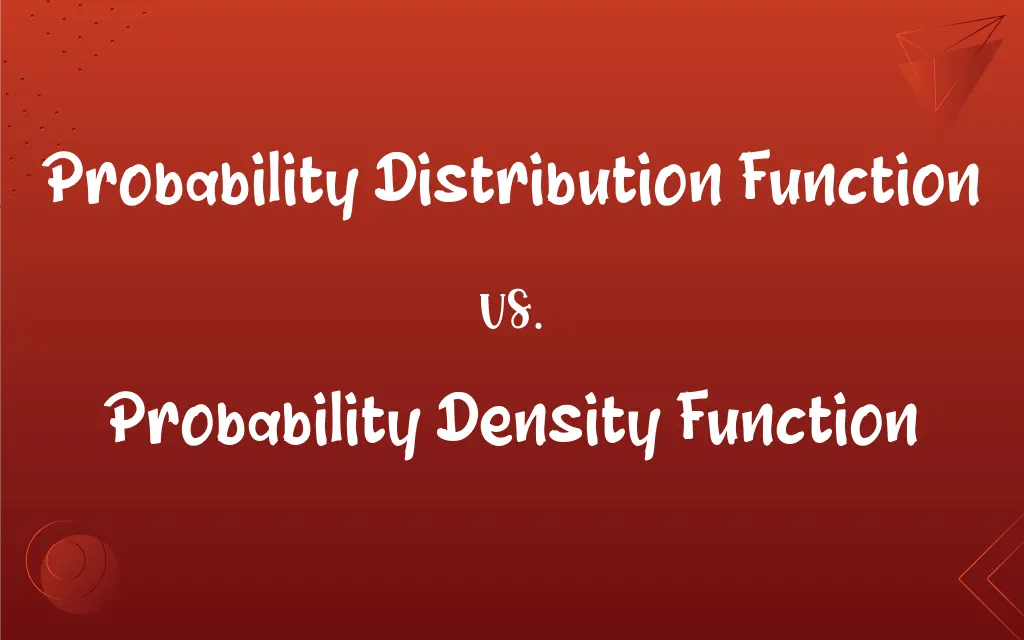Probability Distribution Function vs. Probability Density Function: What's the Difference?
Edited by Aimie Carlson || By Janet White || Published on January 22, 2024
Probability Distribution Function (PDF) describes the probability of a random variable taking on specific values. Probability Density Function (pdf) describes the relative likelihood for a continuous random variable to take on a specific value.

Key Differences
A Probability Distribution Function maps outcomes of a random variable to their probabilities. It applies to both discrete and continuous variables, summarizing the probability structure of the variable. The Probability Density Function, specific to continuous random variables, describes the relative likelihood of the variable assuming a particular value, not the probability itself.
Probability Distribution Function encompasses cumulative distribution functions (CDFs) for both discrete and continuous variables, where probabilities for all values up to a certain point are summed. Probability Density Function is the derivative of the CDF for continuous variables, offering a density rather than a probability for each point.
In the context of a Probability Distribution Function, probabilities for discrete variables are directly obtained for each value, while for continuous variables, it gives the probability that the variable falls within a range. The Probability Density Function provides a function whose integral over a range gives the probability of the variable falling within that range.
Probability Distribution Function is more general, encompassing various forms of distributions (like binomial, normal, etc.) for different types of variables. Probability Density Function specifically deals with continuous variables, describing the distribution's shape but does not give probabilities directly.
In practical applications, Probability Distribution Function is used to calculate probabilities for both discrete outcomes and ranges of continuous outcomes. In contrast, Probability Density Function is used to understand the distribution's characteristics, like its mean or standard deviation, of continuous variables.
ADVERTISEMENT
Comparison Chart
Variable Type
Both discrete and continuous
Only continuous
Function Type
Cumulative for continuous variables
Density function
Probability Calculation
Direct for discrete, cumulative for continuous
Integral over a range for continuous
Information Provided
Probabilities of outcomes
Density of values, not direct probabilities
Usage
Probability calculations
Understanding distribution characteristics
ADVERTISEMENT
Probability Distribution Function and Probability Density Function Definitions
Probability Distribution Function
Represents the cumulative probabilities for continuous or discrete variables.
In a normal distribution, the probability distribution function indicates the probability of falling below a certain value.
Probability Density Function
Describes the relative likelihood of a continuous random variable assuming a specific value.
The probability density function of a normal distribution shows the density of values around the mean.
Probability Distribution Function
A tool for summarizing the probability structure of a statistical phenomenon.
Election forecast models use a probability distribution function to predict outcomes.
Probability Density Function
A function that, when integrated over an interval, gives the probability of the variable within that interval.
Using the probability density function, one can calculate the probability of a variable falling between two values.
Probability Distribution Function
A mathematical description of the likelihood of different outcomes.
The probability distribution function for a coin toss shows a 50% chance for heads or tails.
Probability Density Function
Represents the density of values for a continuous variable, not the probability.
In physics, the probability density function is used to describe uncertainties in measurements.
Probability Distribution Function
A function that assigns probabilities to outcomes of a random variable.
The probability distribution function of a dice roll shows each outcome's likelihood.
Probability Density Function
A tool for understanding the distribution of continuous random variables.
Meteorologists use probability density functions to model temperature variations.
Probability Distribution Function
Determines how probabilities are distributed over the values of a random variable.
For a binomial distribution, the probability distribution function illustrates the probability of successes in a series of trials.
Probability Density Function
A graphical representation of the likelihood of different values of a continuous variable.
The peak of a probability density function indicates where values are most densely concentrated.
FAQs
What is a probability distribution function?
It's a function that provides the probability of outcomes for a random variable.
How does a probability density function differ from a probability distribution function?
A pdf describes the density of a continuous variable, while a PDF provides probabilities for outcomes.
Can the probability density function provide direct probabilities?
No, it gives density values, not direct probabilities.
Are probability distribution functions useful in real-world applications?
Yes, they're widely used in fields like statistics, economics, and engineering.
How is probability density function useful in statistics?
It's used to describe the distribution and density of continuous variables.
Does the probability density function have a maximum value?
It can have a peak, but its value is not a direct probability.
Can probability distribution functions be used for both discrete and continuous data?
Yes, they apply to both types of data.
Is the probability density function applicable to discrete variables?
No, it's specific to continuous variables.
What's the relationship between a probability density function and a cumulative distribution function?
The pdf is the derivative of the CDF for continuous variables.
How do you calculate probabilities using a probability distribution function?
For discrete data, it gives direct probabilities; for continuous data, it's the integral of the pdf.
Can the probability distribution function predict future outcomes?
It provides a basis for probabilistic predictions but doesn't guarantee specific outcomes.
Is the area under a probability density function always equal to one?
Yes, it represents the total probability and must sum up to one.
How is the probability density function used in data analysis?
It helps in understanding the distribution and characteristics of continuous data.
Can the probability distribution function be graphed?
Yes, especially for discrete variables, it can be represented as a bar graph.
What role does the probability distribution function play in hypothesis testing?
It helps determine the likelihood of different outcomes under a null hypothesis.
Does the shape of the probability density function vary between distributions?
Yes, different distributions have uniquely shaped pdfs reflecting their characteristics.
Is the probability density function the same as the probability distribution function for continuous variables?
No, the pdf is related to the PDF but serves a different purpose.
How are probability distribution functions used in risk assessment?
They provide probabilities of various outcomes, helping in evaluating risk.
Are there different types of probability distribution functions?
Yes, including binomial, normal, Poisson, and others, each with specific characteristics.
Can probability density function determine the mode of a distribution?
Yes, the mode is where the pdf reaches its maximum.
About Author
Written by
Janet WhiteJanet White has been an esteemed writer and blogger for Difference Wiki. Holding a Master's degree in Science and Medical Journalism from the prestigious Boston University, she has consistently demonstrated her expertise and passion for her field. When she's not immersed in her work, Janet relishes her time exercising, delving into a good book, and cherishing moments with friends and family.
Edited by
Aimie CarlsonAimie Carlson, holding a master's degree in English literature, is a fervent English language enthusiast. She lends her writing talents to Difference Wiki, a prominent website that specializes in comparisons, offering readers insightful analyses that both captivate and inform.






































































